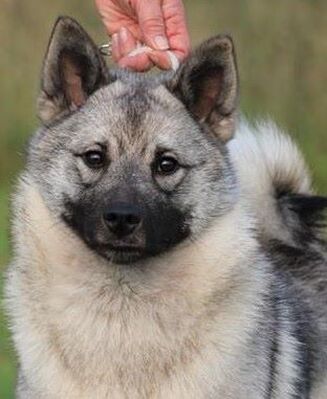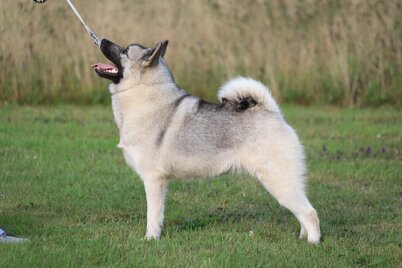About The Breed
|
An Ancient Breed
The Norwegian Elkhound is an ancient breed, having been developed over 6,000 years ago to help early Scandinavians hunt big game such as moose and bear. Remains of dogs remarkably similar to the modern Elkhound have been found in grave sites such as the Viste Cave in Jæren, Norway, where they were dated as far back as 4000–5000 BC. Archaeological digs in Scandinavia suggest this breed existed and was domesticated in the Stone age. At the end of the 19th century the breed came to England, and in 1901 the The Kennel Club officially recognised it. |
A Decedent of the Ancient Pariah Dog
For many years, the Norwegian Elkhound was considered the oldest of all dog breeds, going back further than 6,000 years. Recent DNA analysis suggests, however, that several "ancient" breeds have been "recreated in more recent times from combinations of other breeds" (Ostrander et al., 2004). The researchers found "genetic evidence for a recent origin of the Norwegian Elkhound, believed to be of ancient Scandinavian origin". But this study only includes 85 of the world's more than 400 dog breeds, omits many primitive lineages, and clusters the breeds together into just four major groups called clades. Nevertheless, some researchers say that the Norwegian Elkhound is a descendant of the ancient "primitive" Pariah Dog that existed 4,000–7,000 years ago.Evolved partially from ancestral grey wolf
Of the four major clades that Ostrander et al. clusters together, Clade II includes dogs with the genetic haplotype D8 from two Scandinavian dog breeds: the Norwegian Elkhound and the Jämthund [note: a haplotype is a group of alleles of different genes on a single chromosome that are linked close enough together to be inherited as a single unit]. This genetic sequence haplotype is closely related to two wolf haplotypesfound in Italy, France, Romania, and Greece, and is also related to a wolf haplotype found in western Russia (Vila et al., 1997). Clade II appears to be only seen in Norwegian breeds and exhibits a vast amount of divergences. It is suggested that this clade illustrates an ancient and independent origin from wolves that are now extinct (Raisor, 2004). The Norwegian Elkhound evolved, at least partially, from ancestral grey wolf subspecies now found in south central Europe and western Russia and may very well be one of the most ancient of all dog breeds.
For many years, the Norwegian Elkhound was considered the oldest of all dog breeds, going back further than 6,000 years. Recent DNA analysis suggests, however, that several "ancient" breeds have been "recreated in more recent times from combinations of other breeds" (Ostrander et al., 2004). The researchers found "genetic evidence for a recent origin of the Norwegian Elkhound, believed to be of ancient Scandinavian origin". But this study only includes 85 of the world's more than 400 dog breeds, omits many primitive lineages, and clusters the breeds together into just four major groups called clades. Nevertheless, some researchers say that the Norwegian Elkhound is a descendant of the ancient "primitive" Pariah Dog that existed 4,000–7,000 years ago.Evolved partially from ancestral grey wolf
Of the four major clades that Ostrander et al. clusters together, Clade II includes dogs with the genetic haplotype D8 from two Scandinavian dog breeds: the Norwegian Elkhound and the Jämthund [note: a haplotype is a group of alleles of different genes on a single chromosome that are linked close enough together to be inherited as a single unit]. This genetic sequence haplotype is closely related to two wolf haplotypesfound in Italy, France, Romania, and Greece, and is also related to a wolf haplotype found in western Russia (Vila et al., 1997). Clade II appears to be only seen in Norwegian breeds and exhibits a vast amount of divergences. It is suggested that this clade illustrates an ancient and independent origin from wolves that are now extinct (Raisor, 2004). The Norwegian Elkhound evolved, at least partially, from ancestral grey wolf subspecies now found in south central Europe and western Russia and may very well be one of the most ancient of all dog breeds.


